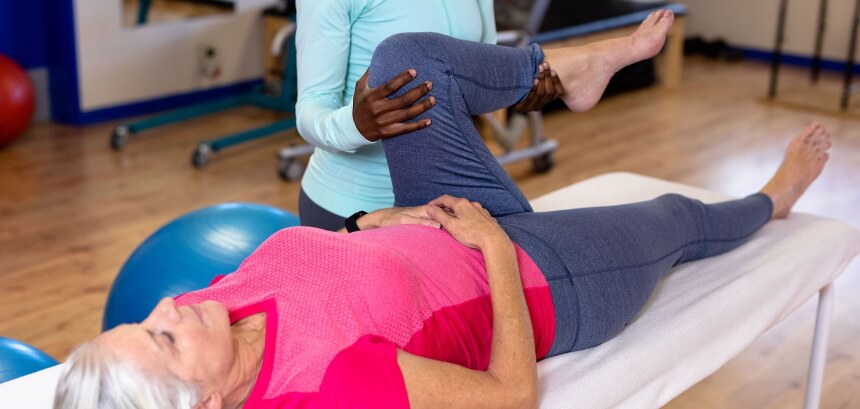

The pain a hernia causes can be relieved by an operation, but figuring out how to sleep after umbilical hernia surgery can be difficult. It’s hard to get comfortable when you’re experiencing post-op soreness, and lack of sleep can make that pain last much longer. Sleep is an important part of the healing process, so it’s important you find a way to get comfortable enough to get adequate sleep during recovery. In this article, we’ll cover how to elevate yourself in bed, the most effective ways to get in and out of bed, things to avoid, and some post-op healing tips too.

With that said, it’s also easy for pillows to shift around throughout the night, especially with people who tend to move around in their sleep. Keeping them in one place can be tricky, but there are specific things you can do to prevent this issue. Wedge pillows are made specifically to prevent slippage throughout the night. On top of that, a full-body pillow can also make the trip while keeping you comfortable at other parts of the body.
Full-body pillows are often recommended by surgeons and physicians after major surgery specifically because they offer far more support than a bunch of regular pillows. With a full-body pillow, you also have the flexibility of sleeping in whatever position is most comfortable for you.
Many customers rave about the 57-inch Amagoing full-body pillow for a variety of reasons. For starters, its U-shape makes it an incredibly stable pillow as it’s held down by your body weight. This means you don’t have to worry about any slipping and moving around while you sleep. To add to that, the inside can be accessed via a zipper. This means you can take out some of the fillings if you feel the standard pillow height for the pillow is too much for you.
However, it’s worth noting that this particular pillow is said to lose height fairly quickly. If you’re just using it for post-operation recovery, it should be fine. But, if you plan to use it as a long-term sleep aid, you may find yourself buying more stuffing often.
Beyond that, keeping elevated while sleeping also depends heavily on a firm mattress that supports your body weight without buckling or giving uneven comfort. Many customers have recommended the Amerisleep AS2 mattress for its level of firmness. The mattress is considered medium-firm, which is nice for anyone who doesn’t like rock-hard mattresses and also doesn’t like a mattress that is too soft either.
The AS2 mattress has consistently won various awards for its quality and sleep guarantee. The mattress is also available in any bed size, which makes it even more popular for being accessible. It uses specific material in the mattress that wicks away moisture while you’re asleep and is far more breathable than its competition.
Full-body pillows
A good full-body pillow, paired with a high-quality mattress, will ensure you stay upright throughout the entire night. There are several different types of full-body pillows one could use, including C-shaped, U-shaped, and cylindrical, to name a few. However, we recommend using a U-shaped pillow as it allows optimal support when getting in and out of bed.

If you step out of bed wrong or lay down without thinking it through, you increase the potential for additional pain. Even after painkillers start to do their work, getting in or out of bed the wrong way can cause your incision to open and potentially become infected. As important as pain management is, taking care of your incision is vital for a speedy recovery.
When getting into bed, there are certain guidelines you should follow. First and foremost, you need to make sure all of your pillows and blankets are in place before climbing in. This is important because once you’re in bed, you aren’t going to want to twist and turn a bunch of ways to get comfortable. The more you move around once in bed, the more likely you are to reopen your incision.
During each of the steps highlighted below, make sure you have a pillow held firmly against your incision to provide an extra cushion. Here’s what you should do to get into bed:
Keep in mind, if you’re using a full body pillow, you’ll just need to lift one side of the “U” up before laying down. Once you’ve made it into bed, you can stay in the side-lying position and straddle the pillow in between your legs.
Getting out of bed should be done with just as much care as getting into bed. In fact, it’s the same process in reverse mode. However, it’s important to remember to hold a pillow against your incision during the process. Here are the steps, in order, for getting out of bed in the morning:
Once again, if you’re using a full-body pillow, then you’ll have one extra step to the process. Before letting your legs dangle over the bed, feed them under the side of the “U” that is on the edge of the bed.

Human beings have an instinctive response to freeze when excessive pain is felt. For this reason, it’s very common to forget about the incision and do something you aren’t supposed to before the spot fully heals. Understandably so, some things can’t wait the full recovery Trusted Source Hernia Surgery & Repair: Larascopic Inguinal Hernia Operation Your doctor can remove your hernia in one of two ways. Both are done at a hospital or surgery center. You’ll usually go home within a few days. In many cases, you’ll be able to go home the same day as your procedure. www.webmd.com period, but there are others that can and should be avoided until you’re completely mended:
Just as each person is unique, the amount of time it takes for someone to recover may be drastically different from that of another person. Regardless of your body’s natural healing clock, there are certain things you can do to help aid in a speedy recovery.
Keep away from strenuous activity
There’s a reason “avoid heavy lifting” is one of the most common instructions given after any surgery. Regardless of how invasive or noninvasive a surgery is, your body still won’t be at 100% immediately afterward. You need to give your body time to heal before doing things like lifting heavy boxes, children, or other objects that require you to bend.
This is especially so with umbilical hernia surgery, as humans need to use core strength and legs to lift heavy objects properly. As your surgery was at or around the belly button, that is quite literally the middle of your core.
Follow all medical instructions

Your post-op instructions are given to you for a reason. Surgery doesn’t magically make the issue go away. Yes, it takes away the source of the problem, but you still need to heal from the process of getting rid of the source.
Wait until your doctor gives the go-ahead
Before going back to your normal daily routine, it’s important to wait until your doctor clears you for work or any other physical activity you’re used to doing. This is to ensure you have ample time to rest and allow the incision site to heal fully. While it may be tempting to go back to your day-to-day right away, doing so will only make a recovery take longer. Perhaps you could pick up a new hobby while you’re stuck resting at home anyways.
Use your support pillow
This piece of advice has been mentioned several times throughout this article and for a good reason. A support pillow not only gives you an extra cushion to protect your incision site, but it’s also essential any time you need to go to the restroom, sneeze, or cough, as those functions require you to constrict those muscles.
Eat a well-balanced diet
Eating nutritious food is important in and of itself. However, it’s even more so after surgery. Your body underwent a significant stressor, and getting enough vitamins, minerals, and other essential substances will help aid in a quick and beautiful recovery.
The bottom line is, recovering from any surgery Trusted Source Hernia Surgery & Repair: Larascopic Inguinal Hernia Operation Most of the time, surgery is the only cure for a hernia. But there are cases where you don’t need to go under the knife. This article explains what you need to know. www.webmd.com takes time and patience. Part of that recovery involves getting adequate sleep, but when it comes to umbilical hernia surgery, that can be difficult. Figuring out how to sleep after umbilical hernia surgery isn’t as stressful as it may seem.
So long as you’re careful about getting in and out of bed and you listen to everything your doctor tells you post-op, you’ll be well equipped to get comfortable while sleeping much quicker.





